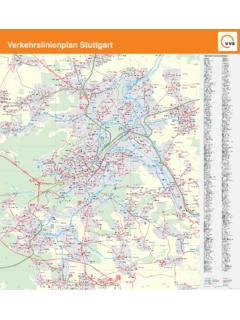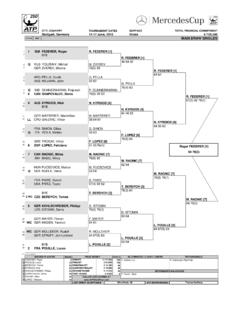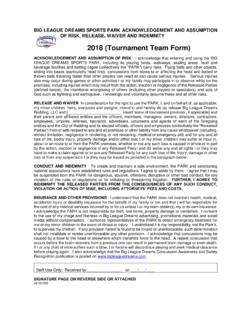Transcription of E-Business: Basics and Challenges - uni-stuttgart.de
1 'Photogrammetric Week 01' D. Fritsch & R. Spiller, Eds. Wichmann Verlag, Heidelberg 2001. Reiss 315. E- business : Basics and Challenges MICHAEL REISS, stuttgart ABSTRACT. The paper first gives an overview of the foundations of e- business . This is accomplished by specifying and differentiating e- business . In addition to this, the spectrum of e- business is outlined. Some reasoning is dedicated to the relevance of e- business in terms of performance potential, range of applications, innovation and implementation. The second part of the paper deals with the critical determinants of successful e- business . Challenges to e- business are related to strengthening success factors, establishing barriers to failure, diminishing barriers to success and fighting failure factors. The paper concludes with an outlook on Challenges in the implementation process.
2 1. Basics OF E- business . Specification of e- business E- business represents a major trend in management, comparable to important business trends like supply chain management, leasing, non-cash payment, mail order commerce or the rise of the service economy. In IT-management e- business can be compared to trends like Enterprise Resource Planning or client-server architecture. E- business primarily stands for internet enabled business . The enabling process is based upon application of internet technologies (Intranets, Extranets) and related standards (HTTP, HTML, XML, CORBA, etc.). It covers several levels (see figure 1). The non-interactive information level serves as a platform for three levels of web-enabled interactions. FIT. COMMERCE. Contract-based transactions with customers COMMUNITY.
3 Mutual support by knowledge transfer COMMUNICATION. Bi / multilateral exchange of information INFORMATION. Access to data LINK. Figure 1: Levels of internet enabled business 316 Reiss Information: On a first level, the Internet can be utilized as a powerful source of information for business purposes. Uncomplicated, "democratic", low-cost access to a plethora of data is provided to a huge number of users worldwide, beyond the restrictions caused by proprietary networks. For vendors, business on the Internet requires (at least) a web-site and a listing in some electronic yellow pages enabling traditional one-way-advertising. To find relevant information customers have to do some surfing, which is supported by numerous services (portals, search engines, etc.) that help to improve transparency of the market.
4 Communication: A simple level of interaction is provided by using the internet as a device for communication. This may be accomplished by e-mail based services ( electronic customer interaction centers for customer questions and complaints) and can attain the more sophisticated level of business portals. Communication is facilitated by the linking of internet users which allows to get in touch with potential business partners worldwide. Community: Furthermore the Internet can be applied for knowledge interchange in specific processes like research, design of systems and solutions and development of software. Among registered community members - like participants in open-source projects ( Linux) - the multilateral exchange of complex information is time- and cost-efficiently accomplished by an Internet platform meeting the security demands of the community members.
5 The community platform hence fosters groupware support for collaboration on the Web. Commerce: The core business functionality of the Internet is the enabling of transactions, contracting, sometimes also fulfillment and billing via Internet. To support these business processes, to coordinate in order to obtain a fit of supply and customer demand, market places, electronic signature or internet-specific payment systems (micropayment, cyber money, etc.) and other infrastructure components have been conceived and implemented. The range of enabling - in terms of number of activities - diminishes from the information to the transaction level: not all surfers on the internet are customers that buy via clicking order forms. Many buyers switch to the familiar realworld channel for the final transaction from informing and communicating on the web.
6 All interaction levels in e- business cover both loose and tight forms of interaction. With respect to closer forms of interaction the label "web-based cooperation" is normally applied. From the viewpoint of a company, e- business supports both extra-company interaction with customers (e-commerce) and suppliers (e-procurement) and intra-company interactions, within intra-corporate project teams or transactions on internal markets. In other words, e-commerce as opposed to e- business covers just one facet of electronic business , selling products via Internet. The e- business trend is connected to several other current internet-triggered trends. In general, e- business is broader than any of these approaches: Multimedia: Information and communication utilizing the richness of digitized and integrated text, sound tracks and graphics (multimedia) is an indispensable device for any e- business as well as a specific business for quite a number of specialized IT-suppliers, designers and content providers, that produce these multimedia products (web-sites, portals, CDs, e-learning courseware, etc.)
7 New Economy: A label used for high-tech products provided by start-up companies and e-lancers (micro-companies). These dotcoms use the internet extensively as an infrastructure for their Reiss 317. business activities (selling, procuring, designing, ..). In some cases they deliver products to enhance this infrastructure for supporting e- business . E- business is broader, since it is not restricted to the New Economy, but also contains various business activities in the Old Economy (like selling cars via Internet). Virtuality: Normally used to describe the absence of conventional and physical features of products ( digital products as opposed to print products) and companies (electronic companies without local branches or geographically concentrated headquarters) while functionality is sustained (see figure 2).
8 The efficiency of e- business heavily relies upon and profits from virtualization. VIRTUAL VIRTUAL. DEVICES PRODUCTS. MEMORY SPACES HOLIDAY TRAVEL. MACHINES BUILT-IN KITCHEN. NETWORKS BUILDINGS.. VIRTUALITY. =. FUNCTIONAL FEATURES. WITHOUT PHYSICAL ATTRIBUTES. CYBERSPACE TELEWORK. CRASH - SIMULATION ASYNCHRONOUS WORK. AVATARS VIRTUAL COMPANIES.. VIRTUAL VIRTUAL. REALITY ORGANIZATION. Figure 2: Facets of virtualization For a detailed clarification of questions like "What is specific about e- business ?" and "In which respects is e- business different from traditional business ?" the modules of e- business as a management system must be outlined (see figure 3). E-strategy is concerned with specific business models like distributing digital products on the Internet channel. Additionally, e- business affects almost all business processes.
9 This holds for customer integration via community models, customer-to-customer-processes ( on demand- triggering of production processes) and changes in the sequence of activities, like the switch from the print-distribute-paradigm to the distribute-print-paradigm. Very often e- business reinforces complex forms of competitive strategies, especially hybrid strategies like mass customization. E-resources cover IT-Infrastructure as well as HR-infrastructure. Appropriate human resources for e- business is not merely a question of e-competencies, handling the Internet, new media and the complexity of e- business (volatility, hyper-competition, etc.). In addition it requires people acting as entrepreneurs (some of them as netpreneurs) rather than as traditional employees or managers.
10 318 Reiss E - STRATEGY E - RESOURCES. business models E - CULTURE IT - infrastructure UNTERNEHMUNGSWANDEL. business processes & STANDARDS. E - competencies TURNAROUND. Coopetition Competitive strategies People KULTURW ANDEL.. Speed .. FITNESS. Netpreneurship UNTERNEHMERTUM. Legal norms .. E - ORGANIZATION. Virtual organization Value nets Cybermediaries .. Figure 3: Modules of e- business E-organization is closely connected to virtual organization and virtual companies. E- business relies on all three dimensions of virtuality, the temporal, spatial and institutional dimension (see figure 4). The way these three dimensions are mixed differentiates two (not mutually exclusive). "archetypes" of virtual organization, virtual companies as electronic companies versus virtual companies as network organizations.






